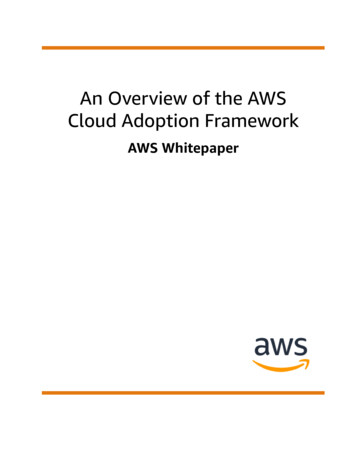
Transcription
An Overview of the AWSCloud Adoption FrameworkAWS Whitepaper
An Overview of the AWS CloudAdoption Framework AWS WhitepaperAn Overview of the AWS Cloud Adoption Framework: AWS WhitepaperCopyright Amazon Web Services, Inc. and/or its affiliates. All rights reserved.Amazon's trademarks and trade dress may not be used in connection with any product or service that is notAmazon's, in any manner that is likely to cause confusion among customers, or in any manner that disparages ordiscredits Amazon. All other trademarks not owned by Amazon are the property of their respective owners, who mayor may not be affiliated with, connected to, or sponsored by Amazon.
An Overview of the AWS CloudAdoption Framework AWS WhitepaperTable of Contents. ivAbstract . 1Localized PDF documents . 1Are you Well-Architected? . 2Introduction . 3Accelerating business outcomes . 4Foundational capabilities . 6Your cloud transformation journey . 8Business perspective . 10People perspective . 13Governance perspective . 16Platform perspective . 19Security perspective . 21Operations perspective . 24Conclusion . 27Appendix: AWS CAF capabilities poster . 28Contributors . 29Further reading . 30Document revisions . 31Notices . 32iii
An Overview of the AWS CloudAdoption Framework AWS WhitepaperAlso available on Audible, Kindle, and as an eBook.iv
An Overview of the AWS CloudAdoption Framework AWS WhitepaperLocalized PDF documentsAn Overview of the AWS CloudAdoption FrameworkPublication date: November 22, 2021 (Document revisions (p. 31))As the proliferation of digital technologies continues to disrupt market segments and industries,adopting Amazon Web Services (AWS) can help you transform your organization to meet the changingbusiness conditions and evolving customer needs. As the world’s most comprehensive and broadlyadopted cloud platform, AWS can help you lower costs, reduce business risks, improve operationalefficiency, become more agile, innovate faster, create new revenue streams, and reinvent customer andemployee experience.The AWS Cloud Adoption Framework (AWS CAF) leverages AWS experience and best practices to helpyou digitally transform and accelerate your business outcomes through innovative use of AWS. Usethe AWS CAF to identify and prioritize transformation opportunities, evaluate and improve your cloudreadiness, and iteratively evolve your transformation roadmap.Localized PDF documentsThe PDF version of this whitepaper is available in the following languages: Arabic ( )عربي Brazilian Portuguese (Português) Simplified Chinese (中文 (简体)) Traditional Chinese (中文 (繁體)) English Finnish (Suomalainen) French Canadian (Français Canadien) French (Français) German (Deutsch) Hebrew ( )עברית Indonesian (Bahasa Indonesia) Italian (Italiano) Japanese (日本語) Korean (한국어) Russian (Ρусский) Spanish (Español) Swedish (Svenska) Thai (ไทย) Turkish (Türkçe) Vietnamese (Tiếng Việt)1
An Overview of the AWS CloudAdoption Framework AWS WhitepaperAre you Well-Architected?Are you Well-Architected?The AWS Well-Architected Framework helps you understand the pros and cons of the decisions you makewhen building systems in the cloud. The six pillars of the Framework allow you to learn architectural bestpractices for designing and operating reliable, secure, efficient, cost-effective, and sustainable systems.Using the AWS Well-Architected Tool, available at no charge in the AWS Management Console, you canreview your workloads against these best practices by answering a set of questions for each pillar.For more expert guidance and best practices for your cloud architecture—reference architecturedeployments, diagrams, and whitepapers—refer to the AWS Architecture Center.2
An Overview of the AWS CloudAdoption Framework AWS WhitepaperIntroductionRapid proliferation of digital technologies has accelerated change and increased competition across arange of market segments and industries. Because sustaining any particular competitive advantage hasbecome increasingly difficult, enterprises are being forced to reinvent themselves at increasingly shortertime intervals. For example, 50% of companies on the S&P 500 are projected to be replaced in the nextdecade.Similarly, peoples’ evolving expectations and behaviors are putting pressure on public sectororganizations to improve digital service delivery. Organizations across the globe are digitallytransforming; they are leveraging digital technologies to drive organizational change that allows them toadapt to changing market conditions, delight their customers, and accelerate their business outcomes.Millions of AWS customers, including the fastest-growing startups, largest enterprises, and leadinggovernment organizations, are leveraging AWS to migrate and modernize legacy workloads, becomedata-driven, digitize and optimize business processes, and reinvent operating and business models.Through cloud powered digital transformation (cloud transformation), they are able to improvetheir business outcomes, including lower costs, reduce business risks, improve operational efficiency,become more agile, innovate faster, create new revenue streams, and improve customer and employeeexperience.Your ability to effectively leverage cloud to digitally transform (your cloud readiness) is underpinned bya set of foundational organizational capabilities. The AWS CAF identifies these capabilities and providesprescriptive guidance that thousands of organizations around the world have successfully used toaccelerate their cloud transformation journeys.AWS and the AWS Partner Network provide tools and services that can help you along each step ofthe way. AWS Professional Services is a global team of experts that provides assistance through acollection of AWS CAF aligned offerings that can help you achieve specific outcomes related to yourcloud transformation.3
An Overview of the AWS CloudAdoption Framework AWS WhitepaperAccelerating business outcomeswith cloud powered digitaltransformationThe cloud transformation value chain in the following figure shows that business outcomes areaccelerated through cloud powered organizational change (transformation) that is enabled by a setof foundational capabilities. The transformation domains represent a value chain where technologicaltransformation enables process transformation which enables organizational transformation thatenables product transformation. Key business outcomes include reduced business risk, improvedenvironmental, social and governance (ESG) performance, as well as increased revenue and operationalefficiency.Cloud transformation value chain Technological transformation focuses on using cloud to migrate and modernize legacy infrastructure,applications, and data and analytics platforms. Cloud Value Benchmarking shows that migrating fromon-premises to AWS leads to a 27% reduction in cost per user, a 58% increase in VMs managed peradmin, a 57% decrease in downtime, and a 34% decrease in security events. Process transformation focuses on digitizing, automating, and optimizing your business operations.This may include leveraging new data and analytics platforms to create actionable insights or usingmachine learning (ML) to improve your customer service experience, employee productivity anddecision-making, business forecasting, fraud detection and prevention, industrial operations, andso on. Doing so may help you improve operational efficiency while lowering operating costs andimproving employee and customer experience. Organizational transformation focuses on reimagining your operating model; how your business andtechnology teams orchestrate their efforts to create customer value and meet your strategic intent.4
An Overview of the AWS CloudAdoption Framework AWS WhitepaperOrganizing your teams around products and value streams while leveraging agile methods to rapidlyiterate and evolve will help you become more responsive and customer centric. Product transformation focuses on reimagining your business model by creating new valuepropositions (products, services) and revenue models. Doing so may help you reach new customersand enter new market segments. Cloud Value Benchmarking shows that adopting AWS leads to a 37%reduction in time-to-market for new features and applications, a 342% increase in code deploymentfrequency, and a 38% reduction in the time to deploy new code.5
An Overview of the AWS CloudAdoption Framework AWS WhitepaperFoundational capabilitiesEach of the transformation domains described in the preceding section is enabled by a set offoundational capabilities shown in the following figure. A capability is an organizational ability toleverage processes to deploy resources (people, technology, and any other tangible or intangible assets)to achieve a particular outcome. AWS CAF capabilities provide best practice guidance that helps youimprove your cloud readiness (your ability to effectively leverage cloud to digitally transform). AWSCAF groups its capabilities in six perspectives: Business, People, Governance, Platform, Security, andOperations. Each perspective comprises a set of capabilities that functionally related stakeholders own ormanage in your cloud transformation journey.AWS CAF perspectives and foundational capabilities Business perspective helps ensure that your cloud investments accelerate your digital transformationambitions and business outcomes. Common stakeholders include chief executive officer (CEO),chief financial officer (CFO), chief operations officer (COO), chief information officer (CIO), and chieftechnology officer (CTO). People perspective serves as a bridge between technology and business, accelerating the cloudjourney to help organizations more rapidly evolve to a culture of continuous growth, learning, andwhere change becomes business-as-normal, with focus on culture, organizational structure, leadership,and workforce. Common stakeholders include CIO, COO, CTO, cloud director, and cross-functional andenterprise-wide leaders. Governance perspective helps you orchestrate your cloud initiatives while maximizing organizationalbenefits and minimizing transformation-related risks. Common stakeholders include chieftransformation officer, CIO, CTO, CFO, chief data officer (CDO), and chief risk officer (CRO). Platform perspective helps you build an enterprise-grade, scalable, hybrid cloud platform, modernizeexisting workloads, and implement new cloud-native solutions. Common stakeholders include CTO,technology leaders, architects, and engineers.6
An Overview of the AWS CloudAdoption Framework AWS Whitepaper Security perspective helps you achieve the confidentiality, integrity, and availability of your dataand cloud workloads. Common stakeholders include chief information security officer (CISO), chiefcompliance officer (CCO), internal audit leaders, and security architects and engineers. Operations perspective helps ensure that your cloud services are delivered at a level that meets theneeds of your business. Common stakeholders include infrastructure and operations leaders, sitereliability engineers, and information technology service managers.7
An Overview of the AWS CloudAdoption Framework AWS WhitepaperYour cloud transformation journeyEach organization’s cloud journey is unique. To succeed in your transformation, you’ll need to envisionyour desired target state, understand your cloud readiness, and adopt an agile approach to closing thegaps. Transforming incrementally will allow you to demonstrate value quickly while minimizing the needto make far-reaching predictions. Adopting an iterative approach will help you maintain momentumand evolve your roadmap as you learn from experience. The AWS CAF recommends four iterative andincremental cloud transformation phases shown in the following figure.Cloud transformation journey Envision phase focuses on demonstrating how cloud will help accelerate your business outcomes.It does so by identifying and prioritizing transformation opportunities across each of thefour transformation domains in line with your strategic business objectives. Associating yourtransformation initiatives with key stakeholders (senior individuals capable of influencing and drivingchange) and measurable business outcomes will help you demonstrate value as you progress throughyour transformation journey. Align phase focuses on identifying capability gaps across the six AWS CAF perspectives, identifyingcross-organizational dependencies, and surfacing stakeholder concerns and challenges. Doing so willhelp you create strategies for improving your cloud readiness, ensure stakeholder alignment, andfacilitate relevant organizational change management activities. Launch phase focuses on delivering pilot initiatives in production and on demonstrating incrementalbusiness value. Pilots should be highly impactful and if/when successful they will help influence futuredirection. Learning from pilots will help you adjust your approach before scaling to full production. Scale phase focuses on expanding production pilots and business value to desired scale and ensuringthat the business benefits associated with your cloud investments are realized and sustained.You may not need to tackle all the foundational capabilities at once. Evolve the foundational capabilitiesand improve your cloud readiness as you progress through your cloud transformation journey. Considertailoring the suggested sequence shown in the following figure to your particular needs.8
An Overview of the AWS CloudAdoption Framework AWS WhitepaperEvolution of AWS CAF perspectives and foundational capabilitiesThe next sections describe each of the six AWS CAF perspectives and the underpinning capabilities inmore detail.9
An Overview of the AWS CloudAdoption Framework AWS WhitepaperBusiness perspective: strategy andoutcomesThe business perspective focuses on ensuring that your cloud investments accelerate your digitaltransformation ambitions and business outcomes. It comprises eight capabilities shown in the followingfigure. Common stakeholders include the CEO, CFO, COO, CIO, and CTO.AWS CAF Business perspective capabilities Strategy management – Leverage cloud to accelerate your business outcomes. Consider how cloudcan support and shape your long-term business goals. Identify opportunities for retiring technical debtand leveraging cloud to optimize your technology and business operations. Explore new cloud-enabledvalue propositions and revenue models. Consider how new or improved cloud-enabled products andservices can help you reach new customers or enter new market segments. Prioritize your strategicobjectives and evolve your strategy over time in response to technological developments and changesin your business environment. Portfolio management – Prioritize cloud products and initiatives in line with strategic intent,operational efficiency, and your capacity to deliver. Delivering the right cloud products and initiativesat the right time will help you operationalize your strategy and accelerate your business outcomes.Leverage automated discovery tools and the seven common migration strategies for movingapplications to the cloud (known as the 7 Rs) to rationalize your existing application portfolio andbuild a data-driven business case.Balance your cloud portfolio by considering short-term and long-term outcomes as well as lowrisk (proven) and higher-risk (experimental) opportunities. Include migration, modernization, andinnovation initiatives, and consider financial (lower costs and/or increased revenue) and non-financial(for example, improved customer and employee experience) benefits. Optimize the business value ofyour portfolio in line with your resource, financial, and schedule constraints. To reduce your time-tovalue, consider increasing the frequency of your planning cycles or adopting a continuous planningstrategy. Innovation management – Leverage cloud to develop new, and improve existing, processes, products,and experiences. By enabling you to instantly provision and shut down resources, cloud can helpyou reduce your time-to-value and innovation-related cost and risk. To fully take advantage of thepotential for increased business agility that comes with cloud adoption, develop an innovation10
An Overview of the AWS CloudAdoption Framework AWS Whitepaperstrategy that includes a mix of incremental innovation initiatives focused on optimizing your existingproducts, processes, and experiences, as well as disruptive innovation initiatives focused on enablingnew business models. Create mechanisms for soliciting and selecting ideas in line with your strategicpriorities, and develop an end-to-end process for scaling successful innovation pilots. Product management – Manage data- and cloud-enabled offerings that deliver repeatable value tointernal and external customers as products through their lifecycles. Organizing your teams arounddata- and cloud-enabled products will help you become more agile and customer-centric: Develop a balanced product portfolio that supports your business strategy. Establish small, enduring, and empowered cross-functional teams that champion the needs ofinternal and external customers. Identify product owners, understand customer journeys, define and create product roadmaps, andmanage end-to-end product lifecycles and associated value streams. Leverage your cloud platform and agile methods to rapidly iterate and evolve. Reduce dependencies between product teams and effectively integrate them into your broaderoperating model via well-defined interfaces. Strategic partnership – Build or grow your business through a strategic partnership with your cloudprovider. If you offer cloud-hosted software solutions, cloud-integrated products, or cloud-relatedprofessional, consulting, or managed services, strategically partnering with your cloud providercan help you build your cloud expertise, promote your solutions to customers, and drive successfulcustomer engagements.As you progress along your partnership journey, leverage promotional credits, funding benefits, andco-selling opportunities to help you build or grow your business. Leverage your cloud provider’smarketplace channel to expand reach, and technical resources to help you mature your cloud-basedproducts and services. Publish joint case studies to highlight success in solving specific businesschallenges. Data monetization – Leverage data to obtain measurable business benefit. Cloud facilitates thecollection, storage, and analysis vast amounts of data. To obtain measurable business benefits,develop a comprehensive and long-term data monetization strategy that’s aligned with your strategicintent. Identify opportunities for leveraging data and analytics to improve operations, customer andemployee experience, and decision-making, as well as to enable new business models.For example, consider leveraging customer behavior insights to drive hyper-personalization andlocalization, micro-segmentation, subscriber retention, loyalty and rewards programs, and thelike. Focus on transactional value that helps you understand and complete business transactions,informational value that helps you describe past performance and infer conclusions, and analyticalvalue that helps you automate activities, guide decisions, and predict outcomes. First monetize datainternally within your organization before considering opportunities for external monetization (forexample, selling data via a marketplace). Business insights – Gain real-time insights and answer questions about your business. Near realtime descriptive insights can help you complete your data monetization strategy by enabling youto track business performance, improve decision-making, and optimize operations. Establish crossfunctional analytics teams with a good understanding of the business context. Focus on technical (suchas statistics) and non-technical (such as visualization and communication) skills. Align your analyticsefforts with business goals and key performance indicators (KPIs). Leverage the Data Catalog tolocate relevant data products, and visualization tools and techniques to discover trends, patterns, andrelationships in the data. Focus on the “big picture” first and drill down into the details as required. Data science – Leverage experimentation, advanced analytics, and machine learning to solve complexbusiness problems. Predictive and prescriptive analytics can help you complete your data monetizationstrategy by enabling you to improve operational effectiveness and decision-making as well ascustomer and employee experience.Once you’ve identified opportunities for business process transformation, ensure that your DataCatalog contains the data products required to support the building, training, and testing of yourmachine learning models. Leverage continuous integration and continuous delivery (CI/CD) practices11
An Overview of the AWS CloudAdoption Framework AWS Whitepaperto improve operational resilience and reproducibility of your machine learning workflows. Understandhow your models make predictions and identify any potential biases. Deploy suitable models toproduction and monitor their performance. To mitigate risk, delegate low confidence predictions forhuman review.12
An Overview of the AWS CloudAdoption Framework AWS WhitepaperPeople perspective: culture andchangeThe people perspective serves as a bridge between technology and business, accelerating the cloudjourney to help organizations more rapidly evolve to a culture of continuous growth, learning, andwhere change becomes business-as-normal, with focus on culture, organizational structure, leadership,and workforce. This perspective comprises seven capabilities shown in the following figure. Commonstakeholders include CIO, COO, CTO, cloud director, and cross-functional and enterprise-wide leaders.AWS CAF People perspective capabilities Culture evolution – Evaluate, incrementally evolve, and codify organizational culture with digitaltransformation aspirations, and best practices for agility, autonomy, clarity, and scalability. Tosucceed in digital transformation, you’ll need to leverage your heritage and core values, while youincorporate new behaviors and mindsets that attract, retain, and empower a workforce that’s investedin continuously improving and innovating on behalf of your customers. Maintain a long-term focus,obsess over customers, and boldly innovate to meet their needs. Institute an organization-wideapproach to recognizing behaviors and goals for all roles that help shape your desired culture.Consider rapid experimentation, agile methodologies, and cross-functional teams to drive ownershipand autonomy, enable rapid decision making, and minimize the need for excessive approvals orbureaucracy. Transformational leadership – Strengthen your leadership capability and mobilize leaders to drivetransformational change and enable outcome-focused, cross-functional decision making. To succeedwith cloud transformation, your leaders must put as much focus on the people side of change asthey do on technology, as without an effective blend of technical and business leadership, yourtransformation may slow down or stall. Gain active and visible executive sponsorship from bothtechnology and business functions, who will make critical decisions on strategy, vision, scope, andresources, and take actions in communication, coalition building, and holding teams accountable forresults.At both the executive and program levels, ensure that your business and technology leaders codevelop, co-lead, and co-deliver culture change strategies. Confirm that each layer of managementdelivers clear and consistent communications to align the organization on cloud value, priorities, andnew behaviors. Consider evolving your cloud leadership function through a transformation office13
An Overview of the AWS CloudAdoption Framework AWS Whitepaperand/or a Cloud Center of Excellence (CCoE) to evangelize and drive your transformation efforts withcodified patterns for consistency and scalability. Incrementally evolve this function to meet yourcurrent needs as you progress through your transformation journey. Cloud fluency – Build digital acumen to confidently and effectively leverage cloud to acceleratebusiness outcomes. The requirement for an exceptional workforce goes beyond adapting to a digitalenvironment, and the greatest challenge is not the technology itself, but, rather, the ability to hire,develop, retain and motivate a talented, knowledgeable, proficient, and high-performing workforce.Given the rapid pace of technological innovation, address your overall training strategy as it relatesto timing, tooling, and technology training, and then assess your existing cloud skills to developa targetedtraining strategy. Implement a skills guild to help you generate excitement and buildmomentum for your transformation journey. Champion data literacy, to advance talent skills andknowledge in data analytics. Combine virtual, classroom, experiential and just-in-time training,leverage immersion days, and validate skills with formal certifications. Implement mentoring,coaching, shadowing, and job rotation programs. Set up communities of practice that own specificdomains of interest. Reward individuals for sharing knowledge, and formalize processes for knowledgeelicitation, peer review, and ongoing curation. Workforce transformation – Enable talent and modernize roles to attract, develop, and retaina digitally fluent high-performing and adaptable workforce that can autonomously drive keycapabilities. To succeed in your cloud transformation, take a proactive approach to talent enablementplanning beyond traditional HR to include C-suite leadership, and modernize your approaches toleadership, learning, rewards, inclusion, performance management, career mobility, and hiring.You will need a diverse and inclusive workforce with the appropriate mix of technical and nontechnical skills. Identify gaps in roles and skills across your entire organization and develop aworkforce strategy that will improve your organizational cloud capability. Leverage talent with digitalskills, and those that are eager to learn, and make an example of them. Strategically consider the useof partners and managed service providers to temporarily or permanently augment your workforce.To attract new talent, build a strong employer brand by publicly promoting your digital vision andorganizational culture, and use it in your recruiting strategy, social networking channels, and externalmarketing. Change acceleration – Accelerate adoption to the new ways of working by applying a programmaticchange acceleration framework that identifies and minimizes impacts to people, culture, roles, andorganization structure when moving from current to future state. Cloud transformation createswidespread changes across business and technology functions, and organizations that apply aprogrammatic end-to-end change process that is structured, integrated, and transparent achievehigher rates of success with value realization and adoption to the new ways of working.Customize and apply a change acceleration framework from project onset to enable organizationalalignment, create a one shared enterprise reality, and reduce waste from the process. Align andmobilize cross-functional cloud leadership. Define what success looks like early in the journey. Envisionthe future by assessing your organization’s readiness for cloud through impact assessments. Identifykey stakeholders, cross-organizational dependencies, key risks, and barri
adopted cloud platform, AWS can help you lower costs, reduce business risks, improve operational efficiency, become more agile, innovate faster, create new revenue streams, and reinvent customer and employee experience. The AWS Cloud Adoption Framework (AWS CAF) leverages AWS experience and best practices to help




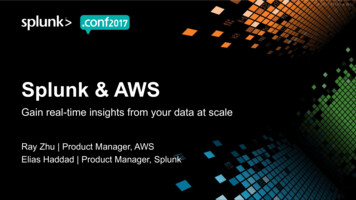
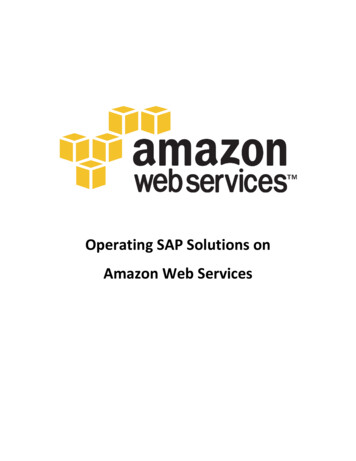
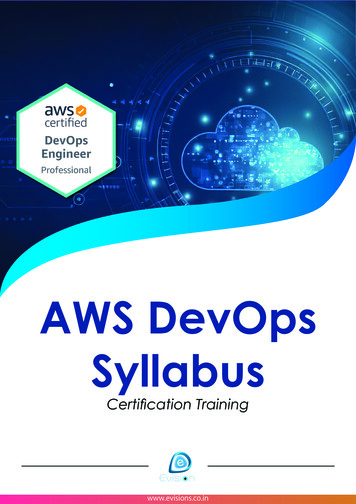


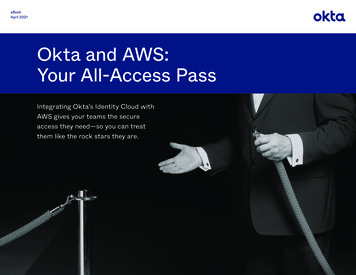
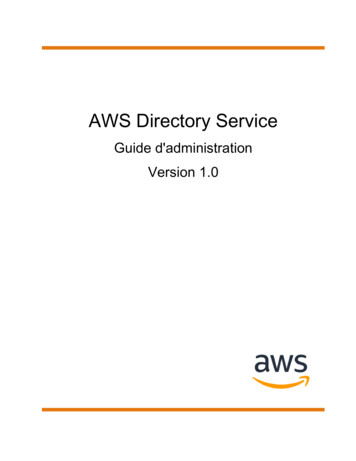
![[AWS Black Belt Online Seminar] AWS X-Ray](/img/17/20200526-blackbelt-x-ray.jpg)